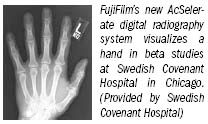Swedish Covenant test drives new flat-panel DR
Fujifilm invented computed radiography. The Japanese company introduced CR to the U.S. nearly 30 years ago.
Fujifilm invented computed radiography. The Japanese company introduced CR to the U.S. nearly 30 years ago. Now it has broken with tradition, developing a flat-panel x-ray system for its U.S. portfolio.
AcSelerate, named for the selenium substrate in its digital detector, does what conventional CR cannot, directly capturing x-rays on a solid-state electronic array and turning them into onscreen images in seconds. Its thick layer of amorphous selenium, coupled with Fujifilm's own image processing software, supports high-resolution imaging at substantially reduced doses of radiation, say company executives.
Dr. Bruce Silver, who served as a luminary for early clinical testing at Swedish Covenant Hospital in Chicago, compared images from the new DR product with ones from Fuji CR systems installed at the hospital.

“What distinguished them was the fine detail in the AcSelerate images of extremity bones,” Silver said. “The trabecular detail was noticeably improved.”
Silver also noted improved interstitial detail in lung images taken with AcSelerate, and brighter contrast.
The turnkey system, featuring a fully automated table and upright stand, includes automated positioning software that aligns the tube and detector to support specific types of exams.
“Technologists don't have to waste time moving the tube,” he said.
Just as maximizing productivity is an issue, so is minimizing dose. Technical measurements put patient dose at about half that delivered using CR, Silver said.
Fujifilm is planning to add features to the system that will extend its clinical capabilities. Updates later this year may allow tomosynthesis and energy subtraction, pending FDA clearance, according to the company.